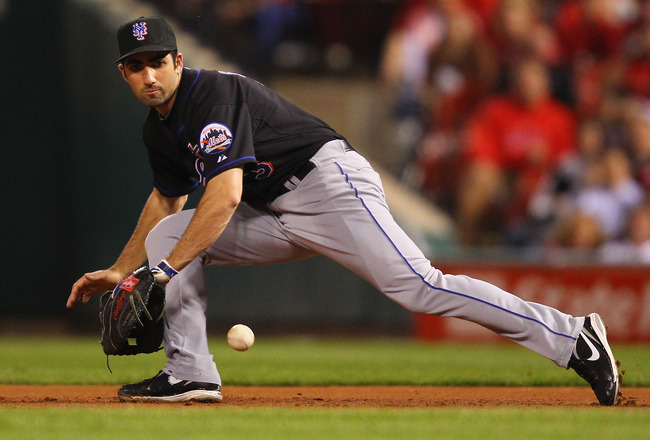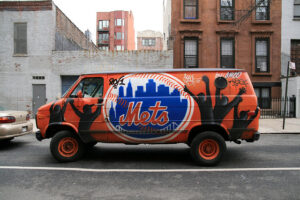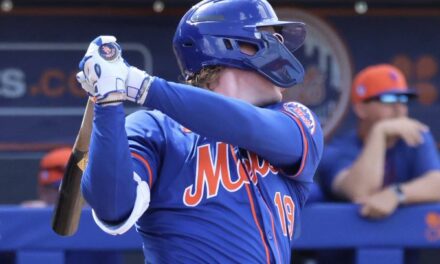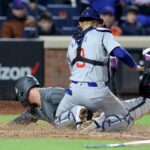In following MMO’s steadfast desire to provide you with the best in-depth analysis of the Mets Minor League farm system, we would like to introduce you to a brand new weekly feature that will appear throughout the off-season. As you can see it’s called: Mets Minor League Positional Depth Chart, and when all is said-and-done you’ll have a much better understanding of the specific strengths and weaknesses of the farm system, as well as an idea as to the overall state of the farm.
This first installment of the new series will feature the position of First Base. In future weeks we will also be doing separate pieces on catcher, the middle infield, the top ten outfielders, the top ten right-handed starting pitchers, the top five left-handed starting pitchers, and the top ten relievers.
A few things to keep in mind for the entire series, which I hope will eliminate some confusion, is as follows:
My criteria for selecting the players on these lists is not based solely on any specific numbers or statistics, especially concerning players in the low levels of the minor leagues where stats are relative and often meaningless.
I am basing these lists purely on a player’s “play-ability,” his upside. I am only listing players I believe to be “big league prospects” not minor league all-stars or big league “suspects.”
I am not saying all of these players will make the big leagues either. Alas, they will not. It’s just not that easy to be a big leaguer. It takes not only talent, but luck. So only about 20 to 30% of these players will ever even sniff the big leagues. But from out of these lists of players the next Ike Davis, or Ruben Tejada, or Matt Harvey will emerge.
So without further adieu, numbers 1 through 5, the best of the Mets’ minor league first-sackers:
1. Aderlin Rodriguez
Originally signed by the Mets as a 16-year-old International Free Agent back in the summer of 2008, Rodriguez has now spent four full seasons in the Mets system playing mostly third-base. He is the prototypical right-handed slugger, and he hits mammoth homeruns whether the wind is blowing or not. Has a tendency to strikeout a wee bit.
He has struggled defensively at third-base during his career so far, and I think it is only a matter of time before he winds up shifting to the other side of the diamond and settling his 6’3″ 220 lb. frame in at first-base. For his career, his Fielding % at third-base is .883, and that is not going to cut it now that he has made it as far as advanced-A ball. Something has to give and I believe this is the year he will make the move. In ten games in his career at first base, he has a FLD% of .977.
For Rodriguez as a hitter, it has been the same as with many power-hitter/run-producer types. He needs to cut down on the strikeouts, through improved pitch selection and recognition. Despite striking out the past two seasons over 100 times each year, he has shown marked improvement in the contact and power aspects of his hitting.
In 2011 with Savannah in the South Atlantic League, his slash-line was .221/.265/.372. He had a K/BB ratio of 106/29. This past season which was split between Savannah and St. Lucie, his slash was .263/.321/.476, showing marked improvement in contact with a .042 point rise, and especially slugging where the improvement was a whopping .104 percentage points. His K/BB ratio in 2012 showed modest improvement at 101/37.
Now for the really cool stuff. He led the entire Mets farm system this past season in home runs with 24, and RBI’s with 83. He finished the season as a 20-year-old in the advanced-A Florida State League with the St. Lucie Mets. Because he only had 153 at-bats with Lucie, he will likely open the 2013 season there for more fun-in-the-sun, with perhaps a mid-season call-up to AA.
2. Josh Satin
When a player spends four years in college, and then gets drafted at the age of 22, it may just take the guy four seasons before he is able to get in a full year at AAA in his fifth year in the organization. If you do the math, that would put him in line to be a 28-year-old rookie in the big leagues in 2013.
Say hello to Josh Satin, who despite his 26 big league at-bats with the Mets, must now wait and see if he gets that coveted spring training “invitation.” Whether he does, or starts the season at AAA, he only has one more year to show the Mets that he can contribute to the big club.
Last year at AAA Buffalo, Satin led the team in at-bats with 441, and hits with 126. He was second on the team in runs scored with 72, home runs with 14, total bases with 195, and walks with 77. And he ranked third on the team in doubles with 25, and RBI’s with 60.
Although Satin has a limited ceiling at this point, he is an experienced player who handles the bat pretty well. He doesn’t have a lot of speed and is limited defensively to being an infield utility guy who doesn’t play shortstop. He profiles as a complimentary player off the bench but whether he fits in to the Mets future plans is very much in question at this point.
3. Jeff Diehl
The opposite end of the spectrum in player development is what transpired to net the Mets this power hitting prospect back in 2011. It was then that Mets made the 6’4″ 195 lb right-handed hitting high school catcher their 23rd round pick in the MLB amateur draft. He decided against college baseball and the Mets signed him late to an over-slot signing bonus of $135,000. He was the best prospect from the state of Rhode Island that year, and made his debut with Kingsport this season.
Back problems in spring training led the Mets to the decision to scrap any plans to keep Diehl behind the plate, and he was moved into the outfield to start the year with a few games sprinkled in at first-base. Having just turned 19, this kid is still growing and he’s going to be a beast and I believe he will ultimately wind up at first-base, if not this year then within the next two seasons.
Lingering back issues throughout the 212 season limited Diehl to playing in roughly 80% of Kingsport’s games in the rookie-level Appalachian League last year. He is still extremely raw and untested and will probably play in Brooklyn next year, but there is no denying the potential of this young man to crush the ball. And of course, that is an extremely rare commodity throughout the Mets organization.
He played primarily outfield this year, 27 games in RF, one game in LF, 12 as a DH, and nine at 1B. He had 43 hits and 18 runs scored in 171 at-bats, with 12 doubles, four triples, two home runs, and 21 RBI’s. His slash-line was .251/.291/.404, but he clearly needs to improve his plate discipline moving forward, as his 64/9 K/BB ratio will attest.
4. Allan Dykstra
Shortly after Sandy Alderson took over as G.M. of the Mets, one of the first trades he made was with San Diego when he sent the Mets 2007 top draft pick (42nd overall) right-hander “Fast” Eddie Kunz to the Pads in return for their 2008 first round pick (23rd overall), first-baseman Allan Dykstra. The 6’5″ 25-year-old lefty slugger, who is no relation to Lenny, has spent the last two seasons playing for AA Binghamton in the Eastern League.
Despite a broken left-arm suffered in a play at first base which wiped out two months of his 2012 season, Dykstra while with Binghamton, has hit a combined 154-for-581, with 92 runs scored, 31 doubles, one triple, 26 home runs, and 102 RBI’s, for a slash of .265/.401/.456. He’s a very good defender at first base even though he throws right-handed. For his five year minor league career, he has had exactly 2400 chances at first, and has put up a FLD% of .986.
Just like in the major leagues, when a minor league player has spent six years in the minors, he then becomes a free agent heading into his seventh professional season, so 2013 will be crucial for Dykstra in regards to his future in the Mets organization.
He should open the season in AAA for the Mets since that roster is basically wide-open at this point, and two seasons at AA should be plenty. His amount of playing time will depend on him, as well as whether or not the front office brings in another slugging first-baseman like Buffalo Bison fan favorite Valentino Pascucci or someone else like him.
5. Jayce Boyd
With their 6th round pick of the 2012 amateur draft, the Mets took Florida State first-baseman Jayce Boyd and signed him to $150,000 signing bonus, $31,700 under the MLB Bonus Pool Amount. The 21-year-old slugger has a quick, smooth, fluid right-hand stroke, and as he settles into pro ball, he should develop into a solid 20 homer a year power guy. Having only just gotten his feet wet in professional baseball so far, he appeared in 54 games for the Brooklyn Cyclones in 2012.
He went 48-for-201, with 18 runs scored, nine doubles, one triple, five home runs, and 19 RBI’s. He also had a very respectable 30/25 K/BB ratio, and a slash-line of .239/.320/.368. An outstanding defensive first-baseman, Boyd put up a FLD% last season of .994 in 492 chances.
Look for Boyd to open the 2013 season in Savannah, probably in a 1B/DH rotation with lefty-hitting Cole Frenzel and another player. Most likely it will develop into a friendly competition between Boyd and Frenzel to see who will get the first promotion to St. Lucie. That will depend on the players just ahead of them at St. Lucie next season, Aderlin Rodriguez and Brian Harrison.
There are some interesting players here, and one or two of them may make the show one day and stay there for a while. But unfortunately the position of First-Base in the Mets minor league system is extremely weak. Rodriguez, Boyd, and Diehl are still many light-years away from the major leagues, and Satin and Dykstra, because of their advanced ages have limited ceilings.
Ideally you want your corner outfield and infield spots to be burgeoning with budding power hitters in a strong and healthy minor league system. That will translate to the same at the big-league level eventually. But the way the Mets organization habitually ignores the element of power hitting (as well as catching and left-handed pitching) in their player scouting, drafting and signing, the team will remain in the “Dark Ages” where power hitting is concerned for quite some time.
















